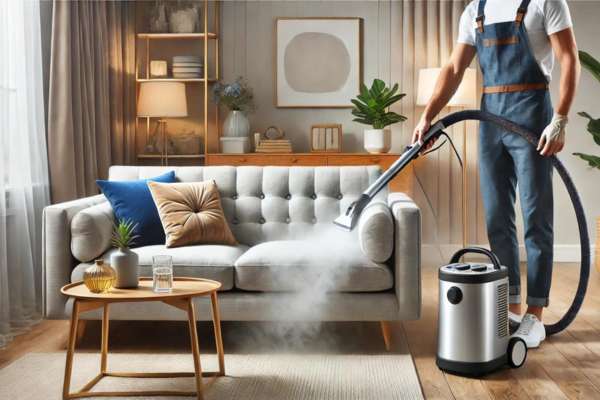Keeping your sofa clean not only enhances the beauty of your living space but also extends the life of one of your home’s key investments. In this guide on “How to Clean a Sofa,” we’ll walk you through various techniques tailored to different types of materials—from fabric to leather. Whether you’re dealing with a fresh spill, stubborn stains, or simply looking to refresh your seating, you’ll find effective methods to maintain your sofa’s charm and comfort. Armed with easy-to-follow advice and some household supplies, you can transform this daunting task into a simple part of your cleaning routine, ensuring your sofa always looks as welcoming as the rest of your home.
Understanding Sofa Materials

Understanding the material of your sofa is crucial for effective cleaning and maintaining its appearance. Fabric sofas often require vacuuming and may benefit from water-based cleaning solutions, whereas leather sofas demand special conditioners to prevent cracks and dryness. Velvet, a more delicate material, needs gentle brushing and dry cleaning methods to preserve its softness and colour depth. Microfiber sofas are stain-resistant and can be cleaned with soap and water, but always check the manufacturer’s instructions. Each material has unique needs that, when met, can drastically extend the life and look of your sofa. Taking the time to identify your sofa’s material can save you from costly mistakes and keep it looking its best.
Regular Maintenance Tips
Regular maintenance is crucial for keeping your sofa in top condition and extending its lifespan. To prevent dirt buildup and preserve the fabric’s integrity, vacuum your sofa weekly using an upholstery attachment. This removes dust and debris before they can settle deep into the fibres. Additionally, consider using protective covers, especially if the sofa is frequently used or in homes with pets and children. These covers not only safeguard against spills and stains but are also easily removable and washable. For added protection, rotate and fluff cushions regularly to ensure even wear and maintain shape. Implementing these simple steps can significantly contribute to your sofa’s longevity and appearance.
Spot Cleaning Techniques

When a spill occurs on your sofa, quick action is crucial to prevent permanent staining. Begin by blotting the spill with a clean, dry cloth; avoid rubbing, as this can spread the stain deeper into the fabric. Once the excess liquid is absorbed, apply a mild cleaning solution suitable for your sofa’s material. Test the cleaner on a small, inconspicuous area first to ensure it doesn’t discolour the fabric. Gently dab the solution onto the stain, working from the outside in to contain it. After treating the stain, blot with a damp cloth to rinse out any soap residue, then dry with a fresh towel or allow it to air dry. This prompt and careful approach can effectively minimise damage and maintain your sofa’s appearance.
Using Homemade Cleaning Solutions

Homemade cleaning solutions are a fantastic way to keep your sofa spotless without relying on harsh chemicals. For fabric sofas, a simple mixture of one teaspoon of dishwashing liquid, one tablespoon of white vinegar, one cup of warm water, and one teaspoon of baking soda creates an effective, eco-friendly cleaning foam. Apply this solution gently with a soft cloth, focusing on stains or soiled areas. For leather sofas, mix equal parts vinegar and natural oil (like coconut or olive oil) to both clean and condition the surface. These natural ingredients are not only safe for most sofa materials but also help in preserving their look and feel over time.
Commercial Cleaning Products

When selecting commercial cleaning products for your sofa, it’s crucial to choose solutions that are as gentle as they are effective. Look for cleaners specifically designed for upholstery, and always check whether they are suitable for your sofa’s material—be it fabric, leather, or microfiber. Products labelled “non-toxic” and “eco-friendly” are preferable, as they are safer for your home environment and tend to be less harsh on the sofa fabrics. Always conduct a spot test in an inconspicuous area to ensure there’s no discoloration or damage. Brands like Woolite, Scotchgard, and Bissell offer a range of trusted cleaners that can revitalise your sofa without compromising its integrity or appearance.
Deep Cleaning a Sofa

Deep cleaning your sofa can revitalize its appearance and hygiene, providing a fresh ambiance to your living space. Begin by thoroughly vacuuming the sofa to remove any loose debris and dust. Depending on the material, either a steam cleaner can be employed for a thorough wash, or a specialized upholstery shampoo might be needed. For fabric sofas, use a soft brush attachment and mild detergent solution, focusing on one section at a time to ensure even cleaning. Leather sofas require a conditioner to maintain their sheen after cleaning. Always perform a spot test on a hidden area to avoid any damage. Allow the sofa to dry completely, ideally in a well-ventilated area, before using it again.
Steam Cleaning

Steam cleaning is a powerful method for rejuvenating your sofa, effectively removing deep-seated dirt, allergens, and odours without the use of harsh chemicals. This technique involves using a steam cleaner to emit hot steam deep into the fabric, which then loosens and lifts dirt for a thorough clean. It’s particularly suitable for water-safe materials and is ideal for households with pets or allergies, as it sanitises without residue. When opting for steam cleaning, ensure your sofa’s fabric can handle heat and moisture by checking the manufacturer’s care label. Regular steam cleaning not only keeps your sofa looking pristine but also contributes to a healthier living environment by eliminating potential pathogens.
Dealing with Odours
Eliminating odours from your sofa can refresh your entire living space, creating a more inviting atmosphere. To tackle unpleasant smells, start by sprinkling baking soda liberally over the sofa’s surfaces and let it sit for a few hours to absorb odors. Vacuum it up thoroughly afterwards. For persistent smells, consider using a fabric deodorizer specifically designed for upholstery that doesn’t leave residues. Additionally, airing out your sofa can also be effective; open windows or use fans to circulate fresh air around the furniture. If the odor remains, placing activated charcoal near the sofa can help absorb lingering smells, ensuring your sofa stays fresh and welcoming.
Conclusion
In conclusion, knowing how to clean a sofa effectively can significantly enhance the look and feel of your living space while ensuring the longevity of your furniture. Whether tackling stains, dust, or odours, each method discussed offers a practical solution tailored to your sofa’s specific needs. Regular maintenance, prompt stain removal, and thorough deep-cleaning are key to keeping your sofa in top condition. Remember, the effort you put into caring for your sofa not only preserves its quality and comfort but also transforms your living area into a more inviting and fresh environment. Embrace these cleaning practices to ensure your sofa always looks its best and remains a cosy centrepiece in your home.

